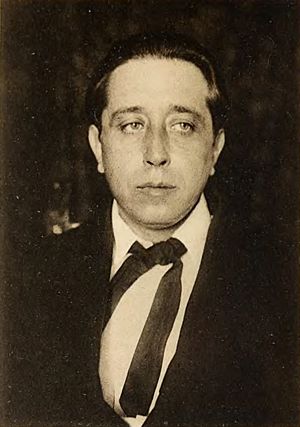Gabriel Miró facts for kids
Gabriel Miró Ferrer (born July 28, 1879, in Alicante, Spain – died May 24, 1930, in Madrid) was an important Spanish writer from the Modernist period. He studied law at the University of Granada and the University of Valencia, finishing in 1900.
Gabriel Miró mainly wrote novels. He also contributed to many newspapers like El Heraldo, Los Lunes de El Imparcial, ABC, and El Sol. He was one of the writers for the magazine Prometeo in Madrid between 1908 and 1912. His books are known for their rich and poetic language, deep ideas about life and religion, and a gentle sense of humor. Gabriel Miró liked to explore the inner thoughts and feelings of his characters. He showed how they developed over time and how they connected with the world around them. He wrote more than 20 novels.
Contents
Gabriel Miró's Books
Gabriel Miró wrote many books that explored interesting ideas and characters. Here are some of his well-known works:
Early Works
In 1915, he published El abuelo del rey (The King's Grandfather). This novel tells the story of three generations in a small town in the Levant region of Spain. It shows, with a bit of humor, the struggle between old traditions and new ideas. It also explores how people are affected by their surroundings and how time changes everything.
One year later, Figuras de la Pasión del Señor (Characters from Our Lord's Passion) was published (1916–1917). This book is a series of scenes about the last days of Jesus.
In 1917, Miró began writing in an autobiographical style. He started with Libro de Sigüenza (Sigüenza's Book). In this book, Sigüenza is like a secret identity or another version of the author himself. This character helps connect all the different scenes in the book.
Personal Stories and Themes
El humo dormido (The Sleeping Smoke) (1919) is one of his most personal books. It includes many moments from his own life. In this book, Gabriel Miró shares his thoughts on topics like childhood, life, death, friendship, innocence, imagination, faith, and beauty. These are also the main ideas found throughout all his literary works. In Años y leguas (Years and Leagues) (1928), he again used his character Sigüenza as the main person in the story, exploring similar themes.
Oleza Novels
In 1921, he finished two more books. One was El ángel, el molino, el caracol del faro (The Angel, the Mill, the Lighthouse Snail), which is a book of scenes. The other was the novel Nuestro padre San Daniel (Our Father Saint Daniel). This book is part of a series that also includes El obispo leproso (The Leprous Bishop) (1926).
Both of these novels take place in the fictional city of Oleza. This city is a reflection of Orihuela, a real city in Spain, during the late 1800s. Oleza is shown as a sleepy place where people experience both deep spiritual feelings and strong physical desires. The characters in these stories often struggle between their natural feelings and what society expects of them. They also face intolerance and religious resistance to new ideas and progress.
Gabriel Miró's Writing Style
Gabriel Miró's stories are often described as lyrical novels. This means they focus more on expressing feelings and sensations rather than just listing events. Key features of Miró's writing include:
- He often uses ellipsis, which means leaving out words or phrases when the meaning is clear.
- He structures his stories in separate scenes that are connected by thoughts and memories.
A main theme in his work is how things change over time. He brings the past into the present through feelings, memories, and recalling events.
Like the writer Azorín, Gabriel Miró believed that our senses help us understand and create. This is why his writing has:
- A very vivid and lively style.
- The use of short, powerful descriptions and images that appeal to the senses.
- Surprising and unique adjectives.
- A very rich and wide vocabulary.
See also
 In Spanish: Gabriel Miró para niños
In Spanish: Gabriel Miró para niños


